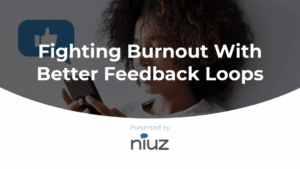Niuz Bites
- Nearly half of frontline caregivers report emotional exhaustion and burnout.
- Regular pulse surveys help leaders identify stress and disengagement before staff walk out.
- Niuz makes collecting, understanding, and acting on feedback effortless.

This blog is a companion post to a webinar we’re hosting Thursday, August 21st called “Fighting Burnout With Better Feedback Loops”. You can register for that webinar by clicking here.

Burnout Isn’t an Event – It’s a Progression

Burnout rarely appears overnight. It builds slowly, day after day, as frustration, fatigue, and feeling ignored pile up. By the time it shows up in turnover metrics or exit interviews, you’ve already lost your chance to help.
According to the National Institute for Occupational Safety and Health (NIOSH), 49% of long-term care employees report experiencing high emotional exhaustion. And the American Health Care Association (AHCA) found that burnout is one of the top drivers of turnover among direct care staff.
The good news? Burnout is often predictable — and preventable — if you’re listening.
The Not-So-Hidden Cost of Burnout
When staff burn out, your organization pays the price in ways that extend far beyond staffing:
- Higher absenteeism and call-outs
- Increased agency reliance and overtime
- Lower morale among remaining staff
- More errors and lower care quality
- Declining satisfaction scores from residents and families
Research published in the Journal of the American Geriatrics Society shows that facilities with higher staff burnout see higher hospitalization rates among residents.
Burnout isn’t just an HR problem — it’s a risk to your entire operation.
Why Annual Surveys Fall Short
Most organizations rely on an annual engagement survey. But in long-term care, the pace is too fast and the stakes too high for a once-a-year check-in.
Here’s why annual surveys often fail:
- Results arrive months after problems begin
- Staff don’t see any action, so trust erodes
- Feedback gets diluted by time and turnover
- It feels like a box-checking exercise, not genuine interest
To create a culture where staff feel heard, you need a feedback system that’s ongoing, actionable, and transparent.
What Pulse Surveys Do Differently
Pulse surveys are short, frequent, and focused. They take the temperature of your team regularly — not just when leadership thinks to ask.
Benefits of pulse surveys:
- Early Warning
You’ll spot morale dips and burnout signals before they become resignations - Trust Building
Frequent surveys show staff you care consistently, not just annually - Actionable Data
Because they’re short, pulse surveys deliver clear signals you can act on immediately
A Gallup study found that employees who strongly agree their employer acts on feedback are four times more likely to stay.
What To Ask In a Burnout-Focused Survey
Effective pulse surveys don’t have to be complicated. Some simple questions might include:
- How would you rate your current level of stress?
- Do you feel recognized for your work this week?
- Do you have what you need to do your job well?
- How connected do you feel to your team?
- Is there anything we can do to support you better?
These questions surface patterns you can’t see on a dashboard of overtime hours.
How Niuz Makes Listening Easy
Niuz builds pulse surveys right into your communication workflow:
- Anonymous Response Tools: So staff can be candid without fear
- Live Dashboards: Visual trends help you track morale over time
- Quick Creation: Create and send a survey in minutes
- Read Confirmations: Ensure participation across all shifts
And because Niuz is accessible on any device, participation stays high – even among staff without (or who never check) email.
Explore our survey features > Click here
Related Reading > Recognition That Sticks
Join Our Upcoming Webinar: Fighting Burnout with Better Feedback Loops
Thursday, August 21st, 2:15PM – 2:45PM ET
Listen Before You Lose Them
Burnout doesn’t have to be inevitable. But if you’re not proactively asking how staff feel, you’re leading in the dark.
When you create a culture of listening, and prove you act on feedback, you build the foundation for stronger retention, happier teams, and better care.